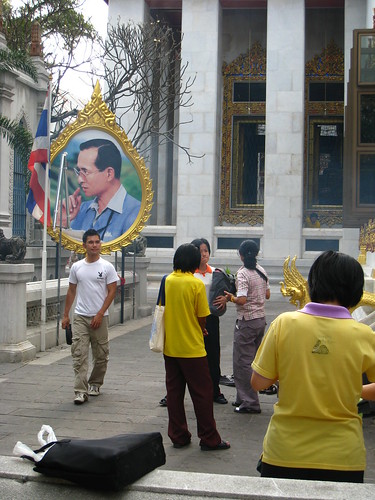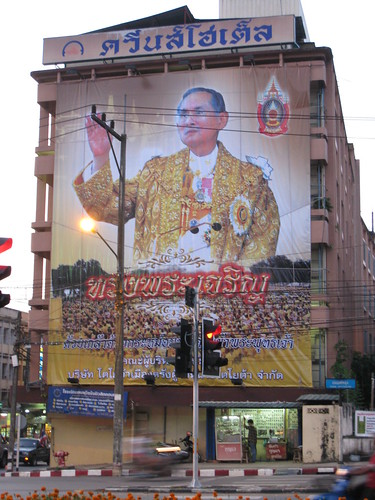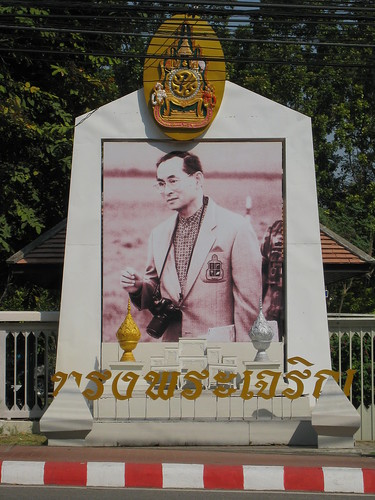 You know whether a place is truly Thai by the t-shirts that the locals wear. If it is a Thai town the locals will wear pink, yellow and blue t-shirts. If it is a town for tourists then they will dress more like westerners that surround them. If it is a Thai town there be lots of shops selling a variety of pink and yellow t-shirts. If it is a Thai town there will be images of the King everywhere.
You know whether a place is truly Thai by the t-shirts that the locals wear. If it is a Thai town the locals will wear pink, yellow and blue t-shirts. If it is a town for tourists then they will dress more like westerners that surround them. If it is a Thai town there be lots of shops selling a variety of pink and yellow t-shirts. If it is a Thai town there will be images of the King everywhere.Any day is a good day to wear yellow or pink. The best day to wear yellow is a Monday when everyone else wears yellow. Thai's wear yellow on a Monday due to that being the King's birthday. If you want to be super patriotic then you can have a yellow shirt with a pink jacket. I even saw a dog whose owner had dyed its fur yellow (I think it was for the King, I can't think of any other reason). The reason why pink became an overnight fashion sensation is because the King left hospital in November wearing a pick jacket. My pink t-shirt has a drawing of the King with "Love King 80" written on it. If you were wondering about blue it is the colour for the Queen.
If Bangkok is a city of villages then Banglampoo and more accurately Khao San Road is the village of the farang. It used to be a backpacker ghetto and is now a place for all the farang passing through. You see the 18 year old backpackers, the too cool for school backpackers, the dreadlocked hippie backpackers, western couples of all ages, western families, and the farang man and thai woman couples (I have never seen the reverse). It has a nice atmosphere to it. Although it is obviously not a Thai area because Thais don't wear pink and yellow t-shirts and you can't buy them here. When you venture outside of Khao San Road arena you see lots of t-shirts being worn and lots of places to buy them. In Chatuchak market I got my blue t-shirt in tribute to the Queen.
Ko Lanta is another farang ghetto. It is a pretty island south of Krabi. I stayed one night at Sea Coconut. I didn't like Ko Lanta because it didn't feel special. It just felt like a westerner holiday spot. The prices were higher than Trang, and nobody was wearing pink or yellow t-shirts. Krabi is a town built on tourism, however, it is not dominated by tourists. I spent a week in Krabi, somewhat unintentionally as a large part was spent sitting on a toilet. The town has plenty of shops selling yellow and pink t-shirts and there are lots of pictures of the King plastered around the town. I visited Rai Leh from Krabi. Rai Leh is a beautiful peninsula with beaches surrounded by karst limestone cliffs. It is full to the brim with tourists. I also climbed Wat Thom Seua. It is a buddhiust temple with a Wat on top of a karst cliff. It is a killer walk (and climb at times) to the top of 1237 steps.
I seem to always get a favourable response from the locals when wearing my pink or yellow t-shirts. I get an even better response in western enclaves when the locals are extremely surprised to see a farang in a pink or yellow t-shirt. I am often asked "Do you love my King?" to which I dutifully reply Yes. The King is a great source of national pride and he appears to be widely loved across the population. Admittedly it is illegal to criticise the King, so liking him is an easier option. The fact that I'm asked "Do you love my King?" and not 'the' King demonstrates the personal pride that the Thai people feel. It is also not something limited to the ethnic Thais. I have seen Chinese and Muslim Thais wearing the t-shirts. I have seen many Muslim women with pink or yellow head scarfs on with the royal insignia. It is not limited to age groups or economic classes. To wear yellow or pink is a sign of being Thai, not a sign of being rich, poor, old or young. There is a topic thread on Thai Forum and a contributor suggests that an element of peer pressure is involved in the fashion trend.
 The King is everywhere in Thailand. There are huge billboard images in every town. The entrance to towns has archways or bridges decorated with pictures of the King and Queen. If you go into shops, guesthouses, or people's homes (they can be all be the same thing) there will be an image of the King or three and maybe a picture of a past favourite King. In markets there are stalls that just sell pictures of the King. There are shops that specialise in King memorabilia. I remember being surprised by seeing a picture of Queen Elizabeth II in Canadian immigration when I crossed from the US. In Britain in recent years support for the monarchy was at its height during the Queen's golden jubilee, I remember lots of flags but I do not remember huge billboards with a picture of the Queen taking a photograph or looking at a map. Here is a link to the BBC News website to an article, "Why Thailand's king is so revered".
The King is everywhere in Thailand. There are huge billboard images in every town. The entrance to towns has archways or bridges decorated with pictures of the King and Queen. If you go into shops, guesthouses, or people's homes (they can be all be the same thing) there will be an image of the King or three and maybe a picture of a past favourite King. In markets there are stalls that just sell pictures of the King. There are shops that specialise in King memorabilia. I remember being surprised by seeing a picture of Queen Elizabeth II in Canadian immigration when I crossed from the US. In Britain in recent years support for the monarchy was at its height during the Queen's golden jubilee, I remember lots of flags but I do not remember huge billboards with a picture of the Queen taking a photograph or looking at a map. Here is a link to the BBC News website to an article, "Why Thailand's king is so revered". The King is not simply respected he is revered. His opinion, his ideas, his actions matter. In Britain amongst the general population I would suggest that the Queen is respected but I would not suggest that this would extend to her opinions on economic or political matters. In Thailand the military coup government adopted as government policy an initiative led by the King for Thai economic self-sufficiency. If you visit the Teak Palace in Bangkok there are two houses devoted to pictures taken by the King. The King is an avid photographer and the displays tell you how he has invented a number of innovative photographic techniques. One gallery relates to pictures taken by the King during flooding in Bangkok in the early 1980s. The captions explain how the King's photographs were clear and enabled officials to see clearly what the problems were and how to deal with them. The King is also a musician. In the gallery are pictures of him playing saxophone with Louis Armstrong.
The King is not simply respected he is revered. His opinion, his ideas, his actions matter. In Britain amongst the general population I would suggest that the Queen is respected but I would not suggest that this would extend to her opinions on economic or political matters. In Thailand the military coup government adopted as government policy an initiative led by the King for Thai economic self-sufficiency. If you visit the Teak Palace in Bangkok there are two houses devoted to pictures taken by the King. The King is an avid photographer and the displays tell you how he has invented a number of innovative photographic techniques. One gallery relates to pictures taken by the King during flooding in Bangkok in the early 1980s. The captions explain how the King's photographs were clear and enabled officials to see clearly what the problems were and how to deal with them. The King is also a musician. In the gallery are pictures of him playing saxophone with Louis Armstrong. If you had been travelling in Thailand for the passed two weeks you might wonder where all these yellow and pink t-shirts are. Princess Galyani Vadhana died on the 2nd January. She was the King's older sister and died of cancer at the age of 84. The country has entered mourning and part of that mourning is to wear black. Here is a link to an article about her death on BBC News. Her death has been met by a reaction similar to that of the Queen Mother's death. Books of condolence have been opened in all towns like in Britain, but unlike Britain the billboard images of the King have been replaced by pictures of the Princess. Thai's have stopped wearing yellow and pink while they mourn her death. The Royal Family are observing 100 days of mourning and those who work for the government have 15 officials days of mourning, they must wear black to work. In the Bangkok Post (15th January 2008) an article entitled "100 days of mourning sought", it begins "The cabinet will today consider extending the official period for Her Royal Highness Princess Galyani Vadhana from 15 to 100 days." In another article in the Bangkok Post they mention how black clothing has been selling out, "In Trang, a clothing shop owner said black t-shirts and suits had been sold out since January 3rd, one day after the Princess passed away".
If you had been travelling in Thailand for the passed two weeks you might wonder where all these yellow and pink t-shirts are. Princess Galyani Vadhana died on the 2nd January. She was the King's older sister and died of cancer at the age of 84. The country has entered mourning and part of that mourning is to wear black. Here is a link to an article about her death on BBC News. Her death has been met by a reaction similar to that of the Queen Mother's death. Books of condolence have been opened in all towns like in Britain, but unlike Britain the billboard images of the King have been replaced by pictures of the Princess. Thai's have stopped wearing yellow and pink while they mourn her death. The Royal Family are observing 100 days of mourning and those who work for the government have 15 officials days of mourning, they must wear black to work. In the Bangkok Post (15th January 2008) an article entitled "100 days of mourning sought", it begins "The cabinet will today consider extending the official period for Her Royal Highness Princess Galyani Vadhana from 15 to 100 days." In another article in the Bangkok Post they mention how black clothing has been selling out, "In Trang, a clothing shop owner said black t-shirts and suits had been sold out since January 3rd, one day after the Princess passed away".
No comments:
Post a Comment